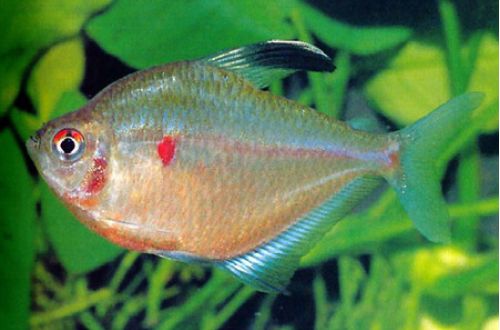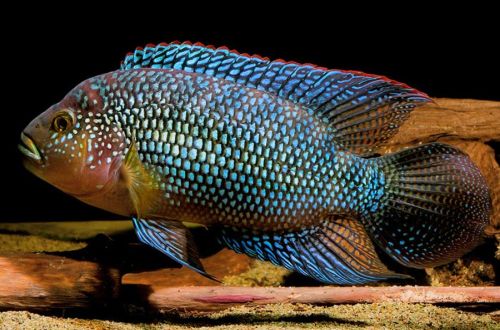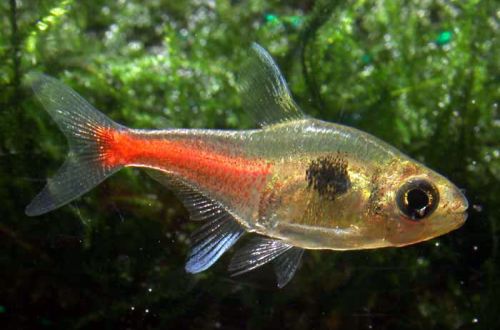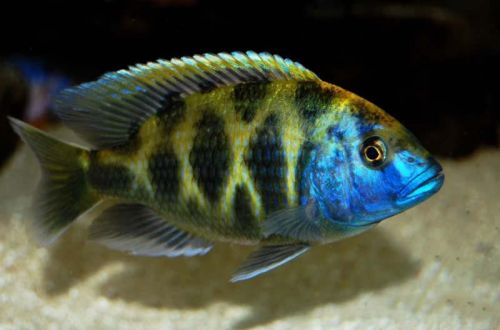
Rubrostigma
Red-spotted Tetra, Rubrostigma or Ornatus red-dotted, scientific name Hyphessobrycon erythrostigma, belongs to the Characidae family (Characinaceae). Peaceful active fish of small size, because of its unusual pattern on the body in English-speaking countries, was called “Bleeding Heart”.

Contents
Habitat
The scientific description was made by the American zoologist Henry Fowler in 1943, studying the fauna of the Amazonian selva. In nature, the fish lives in shallow streams and rivers with dense vegetation in the upper reaches of the Amazon, the water in these reservoirs is usually colored dark brown from decaying organic residues (grass, leaves and other vegetation)
Description
The Redspotted Tetra has a tall, laterally flattened body with a long dorsal fin and a wide anal fin that runs from the middle of the abdomen to the beginning of the tail. The coloration varies from beige-orange to silver, a distinctive feature is the presence of a bright red spot on the body, resembling a heart shape. The dorsal fin has a dark stroke.
Food
With pleasure they accept all types of dry industrial feed, as well as vegetable and meat products. A balanced diet should consist of high quality dry food (plates, flakes, granules), as well as live or freeze-dried bloodworms, the addition of finely chopped spinach or lettuce is welcome.
Maintenance and care
The fish are very hardy and successfully adapt to home aquariums, provided that the water meets the necessary parameters. An important condition is that the water quality must be stable, jumps in the hydrochemical composition adversely affect the Red-spotted Tetra. Water should be renewed by 25-50% every two weeks, while the differences in temperature, pH and dH levels between the old and new should match up to tenths. For example, it is unacceptable to add water with a pH level of 7.0 if the aquarium has a value of 5.0 or 6.0. Of the equipment – a heater, a low-power lighting device, an aerator and a productive filter, the return of water from which is carried out through a sprayer or other method that does not cause a strong movement of water in the aquarium.
Fish prefer dense vegetation, dark river sand and pieces of wood, driftwood, roots, branches, etc. Floating plants provide additional shade, as Tetras do not like bright lights.
Social behavior
Active peaceful schooling fish, prefer a community of their own kind or from representatives of other Tetra species. It is recommended to keep at least 6 individuals in a flock, with a smaller number, their activity may spread to other neighbors in the aquarium, for which this is fraught with damage to the fins.
Sexual differences
The male has wider dorsal and anal fins. The dorsal is somewhat curved and resembles a sickle or arch with bends towards the tail; in the female it is noticeably shorter.
Breeding / breeding
The breeding process is difficult at home, but possible. For breeding, you should prepare a separate spawning aquarium with a size of 30 liters or more. Of the equipment, a filter, an aerator, a heater and low-power lighting devices. The water parameters should be similar to those in the general aquarium. Decoration – dense thickets of plants, including floating ones, sandy dark soil.
Enhanced feeding on meat products gives rise to male courtship procedures for females, which can last for a long time from several days to weeks, since females often ignore any manifestations of attention. You should not wait until the female reciprocates, the couple should be transplanted into a separate aquarium and wait for spawning, while continuing to feed heavily.
Females lay their eggs on floating plants, where they are fertilized, after which the parents are removed back to the common aquarium. Fry appear within five days, feed with microfood or crushed dry food (flakes, granules). The most difficult thing is the daily change of water by 1/3 (the composition of the new and old must match up to tenths) and, if possible, the removal of all uneaten food residues. This procedure should be repeated for two weeks until the fry mature. However, even the creation of optimal conditions does not guarantee survival, the vast majority do not survive to adulthood.
Diseases
Since the fish is sensitive to changes in water parameters, any, even slight fluctuations, provoke the occurrence of diseases such as Ichthyophthyriasis and Velvet Rust. Under favorable conditions, health problems do not arise, more about the symptom and treatment methods in the section “Diseases of aquarium fish”.





